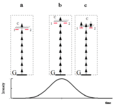Ionization facts for kids
Ionization is a cool process in physics where an atom or molecule changes into an ion. This happens when tiny charged bits, like electrons, are added to or taken away from the atom or molecule.
This process works a bit differently depending on if you're making a positive or a negative charged ion.
How Positive Ions Form
When an atom or molecule loses an electron, it becomes a positively charged ion. Imagine an electron that's usually stuck to an atom. If this electron gets enough energy, it can break free from the atom. The amount of energy needed to kick an electron out is called the ionization energy.
How Negative Ions Form
When an atom or molecule gains an electron, it becomes a negatively charged ion. This happens when a free electron bumps into an atom and gets caught by it. When the electron gets stuck, it releases any extra energy it had.
Images for kids
-
The solar wind hitting Earth's atmosphere creates Auroras. This happens because charged particles get ionized and glow with different colors near the poles.
See also
 In Spanish: Ionización para niños
In Spanish: Ionización para niños





